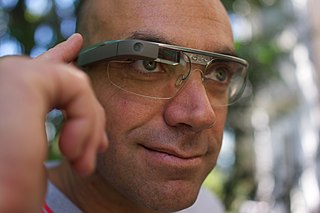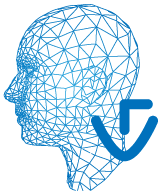Related Research Articles

A facial recognition system is a technology potentially capable of matching a human face from a digital image or a video frame against a database of faces. Such a system is typically employed to authenticate users through ID verification services, and works by pinpointing and measuring facial features from a given image.

Face detection is a computer technology being used in a variety of applications that identifies human faces in digital images. Face detection also refers to the psychological process by which humans locate and attend to faces in a visual scene.

Dazzle camouflage, also known as razzle dazzle or dazzle painting, is a family of ship camouflage that was used extensively in World War I, and to a lesser extent in World War II and afterwards. Credited to the British marine artist Norman Wilkinson, though with a rejected prior claim by the zoologist John Graham Kerr, it consisted of complex patterns of geometric shapes in contrasting colours interrupting and intersecting each other.

Gesture recognition is an area of research and development in computer science and language technology concerned with the recognition and interpretation of human gestures. A subdiscipline of computer vision, it employs mathematical algorithms to interpret gestures.
Facial motion capture is the process of electronically converting the movements of a person's face into a digital database using cameras or laser scanners. This database may then be used to produce computer graphics (CG), computer animation for movies, games, or real-time avatars. Because the motion of CG characters is derived from the movements of real people, it results in a more realistic and nuanced computer character animation than if the animation were created manually.

The PlayStation Eye is a digital camera device, similar to a webcam, for the PlayStation 3. The technology uses computer vision and gesture recognition to process images taken by the camera. This allows players to interact with games using motion and color detection as well as sound through its built-in microphone array. It is the successor to the EyeToy for the PlayStation 2, which was released in 2003.

Object detection is a computer technology related to computer vision and image processing that deals with detecting instances of semantic objects of a certain class in digital images and videos. Well-researched domains of object detection include face detection and pedestrian detection. Object detection has applications in many areas of computer vision, including image retrieval and video surveillance.
Video content analysis or video content analytics (VCA), also known as video analysis or video analytics (VA), is the capability of automatically analyzing video to detect and determine temporal and spatial events.
Viewdle is a Ukrainian facial recognition company. Google was reportedly close to closing a deal to buy the company for between $30 and $45 million in October 2012. In October 2012, Google bought Viewdle to improve Android's augmented reality and face recognition. The company is an expert in the field of computer vision.

Smartglasses or smart glasses are eye or head-worn wearable computers that offer useful capabilities to the user. Many smartglasses include displays that add information alongside or to what the wearer sees. Alternatively, smartglasses are sometimes defined as glasses that are able to change their optical properties, such as smart sunglasses that are programmed to change tint by electronic means. Alternatively, smartglasses are sometimes defined as glasses that include headphone functionality.

Visage SDK is a multi-platform software development kit (SDK) created by Visage Technologies AB. Visage SDK allows software programmers to build facial motion capture and eye tracking applications.

Visage Technologies AB is a private company that produces computer vision software for face tracking and face analysis, along with a special business unit in automotive industry. The primary product of Visage Technologies is a multiplatform software development kit visageSDK.
Emotion recognition is the process of identifying human emotion. People vary widely in their accuracy at recognizing the emotions of others. Use of technology to help people with emotion recognition is a relatively nascent research area. Generally, the technology works best if it uses multiple modalities in context. To date, the most work has been conducted on automating the recognition of facial expressions from video, spoken expressions from audio, written expressions from text, and physiology as measured by wearables.

Megvii is a Chinese technology company that designs image recognition and deep-learning software. Based in Beijing, the company develops artificial intelligence (AI) technology for businesses and for the public sector.

The New York City Police Department (NYPD) actively monitors public activity in New York City, New York, United States. Historically, surveillance has been used by the NYPD for a range of purposes, including against crime, counter-terrorism, and also for nefarious or controversial subjects such as monitoring political demonstrations, activities, and protests, and even entire ethnic and religious groups.
Amazon Rekognition is a cloud-based software as a service (SaaS) computer vision platform that was launched in 2016. It has been sold to, and used by, a number of United States government agencies, including U.S. Immigration and Customs Enforcement (ICE) and Orlando, Florida police, as well as private entities.

Adam Harvey is an American artist and researcher based in Berlin whose work focuses on computer vision, digital imaging technologies, and counter surveillance. His work includes projects combining art and technology as well as speaking and hosting talks on topics relating to data and computer vision.
Xiaoming Liu is a Chinese-American computer scientist and an academic. He is a Professor in the Department of Computer Science and Engineering, MSU Foundation Professor as well as Anil K. and Nandita Jain Endowed Professor of Engineering at Michigan State University.

An anti-facial recognition mask is a mask which can be worn to confuse facial recognition software. This type of mask is designed to thwart the surveillance of people by confusing the biometric data. There are many different types of masks which are used to trick facial recognition technology.
References
- ↑ Valenti, Lauren (March 30, 2018). "Yes, There's a Way to Outsmart Facial Recognition Technology—And It Comes Down to Your Makeup". Vogue . Retrieved February 21, 2019.
- ↑ Melanson, Donald (March 15, 2011). "Student thwarts face detection software with 'CV Dazzle' makeup". Engadget . Retrieved January 7, 2012.
- ↑ "Computer Vision Dazzle Makeup". today and tomorrow. March 31, 2010. Archived from the original on January 25, 2012. Retrieved January 7, 2012.
- ↑ Melanson, Donald (March 15, 2011). "Student thwarts face detection software with 'CV Dazzle' makeup". Engadget . Retrieved January 7, 2012.
- ↑ "Computer Vision Dazzle Makeup". today and tomorrow. March 31, 2010. Archived from the original on January 25, 2012. Retrieved January 7, 2012.
- ↑ Burns, Janet (21 April 2015). "The Anti-Surveillance State: Clothes and Gadgets Block Face Recognition Technology, Confuse Drones and Make You (Digitally) Invisible". AlterNet . Retrieved 3 November 2015.
- ↑ Feng, Ranran; Prabhakaran, Balakrishnan (2013). "Facilitating fashion camouflage art". Proceedings of the 21st ACM international conference on Multimedia. MM '13. ACM. pp. 793–802. doi:10.1145/2502081.2502121. ISBN 978-1-4503-2404-5. S2CID 1547688.
- ↑ Harvey, Adam. "CV Dazzle: Camouflage from Computer Vision" . Retrieved October 26, 2013.
- ↑ Stone, Zara (August 22, 2013). "How to Steal Google Glasses Using Technology". Fusion. Archived from the original on October 27, 2013. Retrieved October 26, 2013.
- ↑ Meltzer, Tom (March 31, 2013). "The anti-drone hoodie that helps you beat Big Brother's spy in the sky". The Guardian. Retrieved October 27, 2013.
- ↑ Caplan, B. (August 20, 2013). "Optic Nerve Video Festival: Jillian Mayer Versus the Surveillance State" . Retrieved October 26, 2013.
- ↑ "CV Dazzle: Computer Vision Dazzle Camouflage". cvdazzle.com. Retrieved 2021-08-07.
- ↑ Sharma, Jeena (16 June 2020). "Why Is Anti-Surveillance Makeup Trending?". Nylon. Retrieved 2021-08-07.
